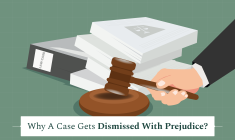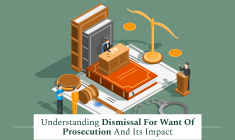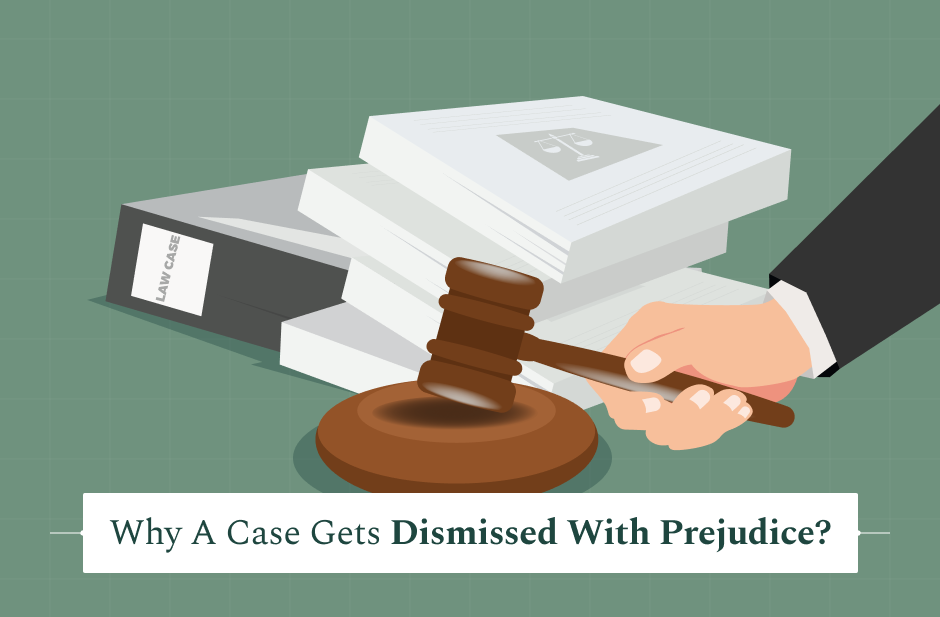Today we talk about instances where a case is dismissed without prejudice. The legal world is full of phrases, some weightier than the other. One such phrase is the “case dismissed with prejudice”. That term quite simply means the end of the legal matter. We should all understand which are the courses that a lawsuit can take.
A dismissal with prejudice forever stops one from taking the claim inside the courthouse door. How to understand such a final judgment? This article tries to shed light on this concept by clearly walking you through what the concept entails. We will outline in this paper the basic definition, serious consequences, and strategic reasons behind such a decision.
What Is Dismissed With Prejudice?
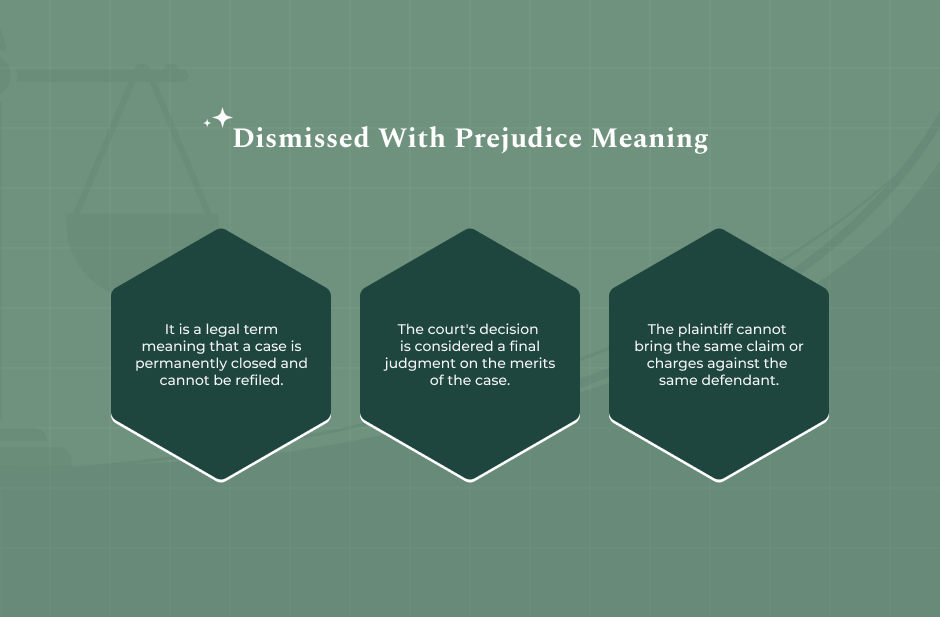
This is but a legal phrase summarizing one strong concept: that of finality. A case dismissed with prejudice cannot be brought back into the courts. The plaintiff loses his right to refile the exact same lawsuit against the same defendant ever again.
Definition And Meaning
Dismissed with prejudice means what it says-the claim is gone, period. The court treats such an act as an adjudication on the merits. Justia Legal Dictionary explains that even when there was no trial, the court treats the result as if the plaintiff lost outright.
Hence, when a claim is dismissed with prejudice, it takes on the force of a final judgment. Perhaps it is that the legal system has indicated indeed that the matter is now finally settled.
The Principle Of Finality, Res Judicata
The law demands stability. The whole concept of a case being dismissed with prejudice is based upon deep legal doctrine. That doctrine is res judicata, Latin for “a matter judged.“
Res judicata denies parties unlimited use of the courts. Once the court ruled that the case is dismissed with prejudice, the claim is officially considered resolved Cornell Legal Information Institute. The principle ensures efficiency.
It keeps dockets clear. Most importantly, according to this, defendants cannot be sued more than once for any single harm. A case dismissed with prejudice is final and will not be changed under any circumstances.
Dismissal Type – With Vs. Without Prejudice
The following is a summary of the main difference between the two kinds of court dismissals that determines the finality of the case.
Dismissed With Prejudice (DWP)
This Order finally determines the merits of the action.
- Outcomes: Decision/ Verdict.
- Refiling: Prohibited. The claim is hence barred.
Dropped With No Prejudice
This is a temporary procedural ruling, usually on grounds of technical mistakes.
- Outcome: Interim order.
- Refiling: The plaintiff is usually able to re-file the case later.
A without prejudice ruling provides a plaintiff with a second chance. He or she can rectify a technical mistake, pay a fee, or secure necessary information. By contrast, a case dismissed with prejudice does not grant such second chances. The matter is closed.
Under what circumstances, and for what reasons, would a case be dismissed with prejudice?
The courts never whimsically dismiss a claim with prejudice. Since the judgment is final, it calls for sound legal reasoning. Herein are the most frequent reasons why the judge issues such a final order.
Causes Based On The Merits Of The Claim
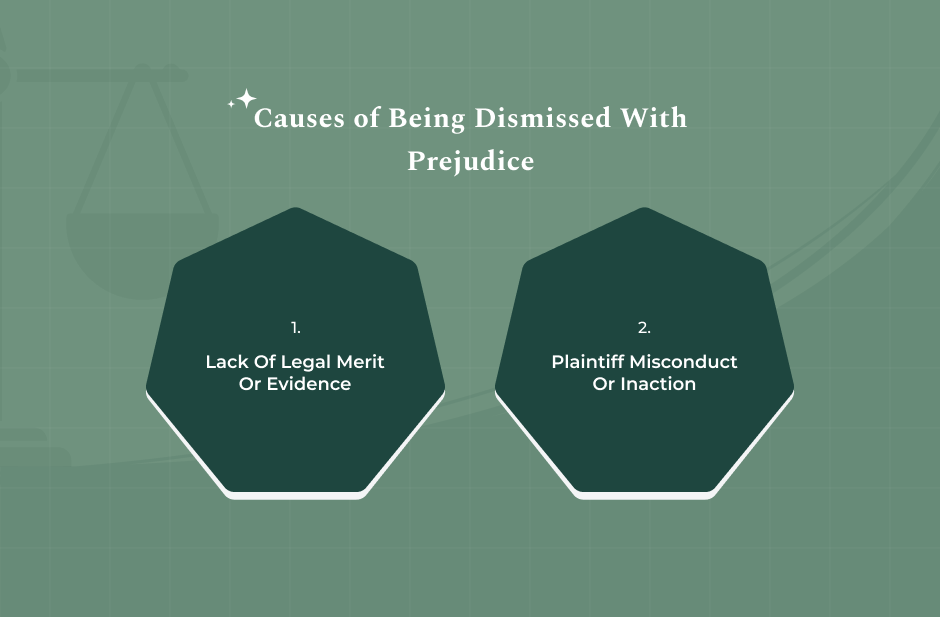
Most dismissals occur simply because the claim lacks legal standing.
1. Statute Of Limitations Expiration
Well, all legal claims come with a deadline. This deadline is the statute of limitations. Any lawsuit filing after that deadline gives the defendant the legal right to dismiss the claim. The judge in such cases gives the verdict of lawsuit dismissed with prejudice. After all, law bars any kind of action, altogether.
2. Failure To State A Claim
The law requires that a plaintiff show he is entitled to relief. There can be cases where a complaint of the plaintiff does not meet this bare minimum legal requirement. Additionally, if he is unable to cure the defects notwithstanding successive efforts, the court may order the action be dismissed with prejudice. The law provides no remedy for the facts presented.
Causes Based On Severe Misconduct (Sanctions)
The plaintiff’s litigation conduct sometimes provides cause for the ruling. Very bad behavior will again lead to dismissal with prejudice.
Failure To Prosecute
When a plaintiff starts a lawsuit and thereafter does nothing to prosecute it-meaning he fails to show up for hearings, refuses to attend depositions, or neglects to timely comply with court-set deadlines-the judge may consider that abandonment of the case.
The judge could dismiss the case with prejudice to be fair to the defendant.
Willful Discovery Violations
Intentional destruction of essential evidence or persistent disregard of a court’s directive concerning the discovery, which involves the revelation of information, may be met with severe penalties.
Such bad faith merits the punishment of the court by ordering the claim to be dismissed with prejudice. Such is to prevent abuses of the court system.
The Role Of Voluntary Settlement
Not all judgments are punitive in their sort. A common legal option is that of one’s voluntary dismissal with prejudice.
When the defendant agrees to pay a settlement, they want full protection from any future lawsuits based on that incident. Thus, the settlement agreement requires the plaintiff file an agreement of sorts with the court.
Therefore, this document very clearly declares that the case is dismissed with prejudice. This protects the defendant.
That means the defendant pays the settlement funds and knows the legal matter is closed forever. The plaintiff gets paid. However, their right to sue on that matter is now dismissed with prejudice.
Major Consequences Of Being Dismissed With Prejudice

From the very moment that a case is ruled to be dismissed with prejudice, the legal status of the parties is forever changed.
The Plaintiff’s Closed Door
For the plaintiff, this means serious implications:
Claim extinguished means the suit is over. Thus, plaintiff cannot file the same suit in state court, federal court or otherwise. The claim is dismissed with prejudice permanently.
This would include the following:
Loss Of Investment
Time, energy, and money spent in filing and following up on the claim are lost. Unless the dismissal was part of a settlement, the plaintiff gets nothing.
Limited Appeal Rights
In the event of the plaintiff not re-filing the action, their only avenue for appeal remains with the initial order of the judge who ruled that the case be dismissed with prejudice.
The Defendant’s Total Victory
The best of all possible results for the defendant is, of course, a claim dismissed with prejudice because such a result provides complete, guaranteed closure.
Zero Risk Of Relitigation
This is absolute immunity from the claim of the defendant. Thus, the defendant will never face the same lawsuit again.
Recovery Of Defensive Costs
The defendant can request, in special circumstances, that the plaintiff pay for the costs of its defence. When such an order has been given by the court-often because the plaintiff was dismissed due to extreme misconduct-this would have set in concrete the strength of the Dismissal with prejudice.
The Appeal Exception
Remember this critical difference:
A plaintiff cannot refight a case dismissed with prejudice. They can, though, appeal the final judgment.
You argue, when appealing, that the trial judge has committed an error of law or procedure in issuing the order for the case to be dismissed with prejudice.
If the appeals court agrees, it can reverse the ruling and allow the plaintiff’s claim to proceed. If that appeal fails, the original ruling stands, and the matter remains dismissed with prejudice.
Read Also: Understanding Dismissal For Want Of Prosecution And Its Impact
Practical Application – How To Handle Permanent Termination
The parties must therefore strategize on how to use or oppose a motion for case dismissal with prejudice.
Checklist for Plaintiffs:
1. File On Time
Absolutely, check the statute of limitations. One day late filing generally ensures dismissal of the claim with prejudice.
2. Diligence Is Key
Comply with all directions of the court. You can have your case dismissed with prejudice for failure to prosecute it in a pretty short period of time.
3. Stipulation Review
If you’re settling, have the check in hand before signing any stipulation the case is dismissed with prejudice.
Checklist for Defendants:
1. Motion To Finality
If a claim has expired under the statute of limitations or is legally insufficient, immediately make a motion to the court for a ruling that the case be dismissed with prejudice. This protects your interests.
2. Document Misconduct
Document every deadline that was missed or discovery violation the plaintiff has committed. This is going to be your evidence to support your motion that the claim be dismissed with prejudice as a sanction.
3. Confirm The Wording
Every settlement agreement you enter into should include verbiage about the case being dismissed with prejudice. Never accept the ambiguous “without prejudice.”
Expert Tips- Protect The Future Of Your Claim
Where there is an issue of possible dismissal, details will come into play. They determine whether your case is dismissed with prejudice or continues on.
Specific Order
Read what the judge has ordered in writing. Often, this document refers to a specific rule that can explain why the Dismissal with prejudice occurred. Read it carefully.
Consult Local Counsel
Rules differ from state to state, and even from county court to county court. A local attorney will be familiar with minor jurisdictional differences in areas where the court finds a case dismissed with prejudice due to issues like procedural errors.
Power Of Amendment
Wherever a defendant moves to dismiss your case, you must invariably ask for leave to amend your complaint. If you are denied such an opportunity to amend, the case is much more likely to be dismissed with prejudice.
Frequently Asked Questions (FAQs):
An order dismissed-with-prejudice dismisses your lawsuit forever. It basically cements the court’s decision on the merits and bars any future litigation on the same matter.
Understanding this last step is important in safeguarding your rights.
It only precludes the same claim, meaning the same parties, same basic underlying facts and same cause of action. If the defendant hurts you in a completely different incident later on, you can sue them for that new action, so long as it is not beyond the statute of limitations. The original case dismissed with prejudice does not protect them from entirely new, unrelated claims.
A criminal case dismissed with prejudice means the government cannot recharge that defendant with that particular crime. That is common in cases where there has been severe police or prosecutorial misconduct or violation of the constitutional rights of the defendant, such as his or her right to a speedy trial.
While that does not legally prove innocence, the effect is the same: the charge is permanently barred, and the prosecution cannot proceed.
No, a settlement that includes being dismissed with prejudice binds both parties. You settled the issue, and the final order prevents either you-the plaintiff-or the defendant from ever bringing the same claim again.
The finality of the Dismissal with prejudice protects you as much as it protects the opposing party from your original claim.


